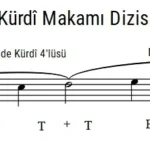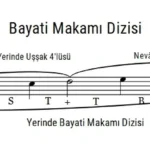It is one of the very old makam (modes) of Turkish music and consists of the “inici” (sharp) form of the Hüseynî makam. Abdülbâki Nâsır Dede mentions it among the muhayyeri compositions. Its scale, established on the Dügâh note, is exactly the same as the Hüseynî makam scale, which is why this makam is classified among the simple makams.
The Muhayyer makam has been highly appreciated and widely used in Turkish music’s vocal religious and non-religious works, instrumental pieces, as well as in almost every form of classical art and folk music.
Muhayyer Ney Taksimi – Niyazi Sayın
The final note is Dügâh (A).
The melodic contour is descending.
Formed on the Dugâh pitch by combining the Hüseynî pentachord with the Uşşak tetrachord at Hüseynî
As seen, this scale is exactly the same as the Hüseynî makam scale. However, due to its raised (sharp) notes, the Muhayyer makam begins its melodic progression from the higher tonic. To create a melodic passage in this section—just like in almost all sharp (inici) makams—the Hüseynî pentachord on the tonic is symmetrically transposed onto the higher tonic note of Muhayyer. This way, both the makam is expanded, and a melodic area for the introductory phrase is established.
Since this expanded section is used right at the beginning of the melodic progression, it can be considered as an integral part of the main scale.
The primary dominant (first-degree strong note) of the Muhayyer makam is the Muhayyer note. If the melody descends from the high Hüseynî note and takes a half pause on Muhayyer, the flavor is Hüseynî. If it descends from the high Nevâ and similarly takes a half pause on Muhayyer, the flavor is Uşşak.
The second strongest note is the Hüseynî note at the junction of the main scale. The flavor on this note is Uşşak; however, if the descent is made using the high Bûselik instead of high Segâh and the melody settles on the Hüseynî note, it is called Hüseynî in Hüseynî.
The most important secondary tonic note is Nevâ, on which a Râst-flavored secondary tonic can be made. This secondary tonic on the Nevâ note serves as a small modulation to the Tâhir makam. Additionally, the Çârgâh and Segâh notes are also used as secondary tonic notes, just like in the Hüseynî makam. That is, secondary tonics with Çârgâh or, rarely, Pençgâh flavor can occur on the Çârgâh note. On the Segâh note, secondary tonics can be made using the Segâh, Ferahnâk, or Eksik Ferahnâk pentachord, or with the Segâh triad.
The key signature includes a 1-comma flat for B (Si) and a 4-comma sharp (bakiye) for F (Fa)
Dügâh (A), Segâh (B lowered by 1 comma – approximately B double flat), Çârgâh (C), Nevâ (D), Hüseynî (E), Eviç (F), Gerdâniye (G), and Muhayyer (A) correspond to the following notes.
In the expanded section: High Segâh (B lowered by 1 comma – approx. B♭♭), High Çârgâh (C), High Nevâ (D), and High Hüseynî (E).
It is the G (Sol) pitch on the second line (Râst).
The Hüseynî pentachord located on the tonic is symmetrically transposed to the upper part of the high tonic. (See: Scale)
The melodic progression begins around the high tonic, the Muhayyer note. After exploring the upper register around the Muhayyer note, a half cadence is made on Muhayyer. Then, the secondary dominant, the Hüseynî note, is used for a secondary (temporary) cadence. Along the way, other necessary secondary cadences are also applied where appropriate. Finally, after some melodic wandering, a full cadence is made on the Dügâh note using the Hüseynî scale.
Note: If, after performing this makam, a cadence is made on the spot using the Bûselik scale or pentachord, the Muhayyer Bûselik makam is formed; if a cadence is made using the Kürdî scale, the Muhayyer Kürdî makam emerges.







